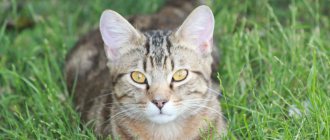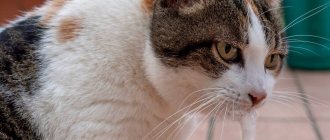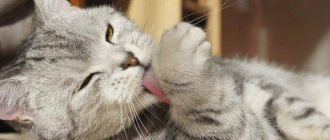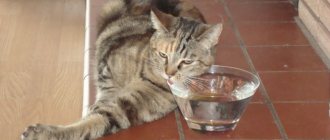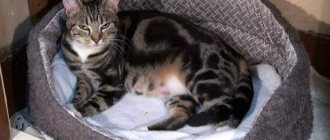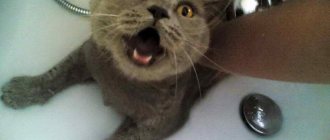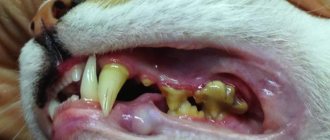How long can a cat go without food? – Reality
A cat can live up to two weeks without food as long as it still drinks water. But if the cat doesn't drink water either, it won't live more than a few days.
No creature can go without food and water for a long time, and cats are no exception. When a feline skips meals or refuses to eat, there is a reason. It is vital that contacting your veterinarian is your first step in uncovering what is really going on.
Firstly, is your cat not hungry, but drinking, or refusing both altogether? Cats generally cannot live long without water. So, if your cat doesn't drink, she has no more than three days to live, and in that time, irreparable damage can occur.
If they drink but don't eat, they can live up to two weeks. This is dangerous territory, as malnutrition can cause a number of other problems that your cat may have before hunger takes its toll.
© shutterstock
If your cat suddenly stops eating, especially if she is losing weight, you must act quickly. If your cat skips a meal here or there, your kitty may be pickier. In any case, maintaining their health is the main responsibility of the cat owner.
Cat and water standards
The most important thing that a cat’s body needs is clean and high-quality water in sufficient quantity for normal life, which depends on:
- Ambient temperatures. During the hot season, your pet drinks much more than in winter, spring or autumn.
- Diet. A pet on natural food gets some of its moisture from food - meat, cereals, dairy products. Dry industrial mixtures (high class) contain all the necessary substances in sufficient quantities, but increase thirst.
- Breeds. Some individuals, due to the characteristics of their organism, manage with a small amount of liquid, for example, the British or Scottish fold. Others drink water often and in large quantities. These varieties include the Bengal cat.
- Individual characteristics. The age of the cat and its state of health also significantly affect the amount of fluid consumed by the animal. Typically, the older the pet, the more he drinks.
A cat's body contains about 70% water. The average fluid intake per day for an adult is from 200 to 300 ml.
It has been established that the maximum period a pet can go without drinking without disrupting the normal functioning of the body is two days. Further dehydration quickly weakens the animal; after five days of a dry diet, the cat may die.
Dangers of no water intake
Not eating is bad, yes. But lack of hydration can get worse and faster. It is very important to make sure that your cat gets fluids in any way possible so that she will accept it. Not drinking for long periods of time can cause irreversible problems and wreak havoc on their body.
Your cat's body is made mostly of water, just like ours, and makes up more than 80% of its being. Every organ, tissue and vessel needs water to function. Cats are already prone to dehydration, so not drinking completely is very bad for them.
When your cat stops drinking, her condition will quickly worsen and she will begin to suffer from dehydration. The longer the body goes without fluid, the more organs begin to shut down one by one. Their body will stop the flow to the less important organs first, making sure the most important ones continue to function.
The more fluid is lost, the more organs fail. By the third day of no water, the body will completely shut down. If your cat refuses to drink, your veterinarian may need to administer intravenous fluids to prevent permanent organ damage or death.
Diagnosis of dehydration
In order to make a diagnosis, in a veterinary clinic, a sample of the pet’s skin is taken to assess the degree of its elasticity, and the degree and rate of filling of small blood vessels - capillaries - with blood is determined. Urine and blood analysis is mandatory to identify the severity of the clinical case and complications resulting from a long-term lack of water.
It is not possible to carry out these tests independently at home. However, there is one way to determine such a state, although its result cannot be called absolutely accurate.
If signs and symptoms of dehydration appear, apply pressure with your finger to the gum. If pressure causes a white spot to appear on the gum that lasts 3 seconds or longer, the deterioration in health is most likely caused by dehydration.
How to convince your cat to eat or drink
There are a few things you can try at home before visiting the vet to encourage your cat to eat or drink. Depending on the actual cause of the symptom, you can feed and drink water, even if it is a small amount.
But these methods do not replace the attention of a veterinarian. Chances are, if your cat refuses to eat or drink, something terrible is happening that will require further monitoring and treatment.
© shutterstock
Signs of dehydration
If there is nothing alarming about the owner’s pet’s behavior or state of health, then he will not follow him around to observe how often and in what volume he drinks water. This is where the danger lies. If an animal voluntarily refuses to drink, this is not immediately detected, which is why the pet develops dehydration.
When this pathological condition appears, which is dangerous both for the health and life of the cat, a certain symptomatic picture arises. The intensity of signs of dehydration increases rapidly. Dehydration in cats is indicated by:
- Gradual decrease in the animal’s motor activity. This is especially noticeable in those pets who were previously active and playful, but now spend most of their time lying down.
- Prolonged constipation.
- Saliva that becomes too viscous and sticky.
- Rare urge to urinate, decreased urine volume. In severe cases, the animal stops going to the toilet altogether.
- Decreased body temperature. For cats, a normal temperature is considered to be from +37 to +38°C. But as dehydration develops, this figure decreases; the pet’s body temperature can drop to 36.5°C or less.
- Increased pulse and heart rate.
- Dry, pale gums and oral mucosa.
- Dull eyes that can “sink.”
- Deterioration in the condition of the coat - it begins to rapidly fall out, often in whole clumps, loses its shine and color, becomes dull and faded.
If you detect at least 1-2 of the above signs, you should immediately contact a veterinarian. Dehydration leads to total pathological changes in the animal's body. It will not be possible to cope with them just by forcefully pouring water into the oral cavity; complex drug therapy with shock doses of vitamins and nutrients is required.
Reasons why cats may stop eating
Cats can be finicky creatures. The reasons why they stop eating may be emotional or physical. Most often, cats stop eating for one of the following reasons:
- Depression or anxiety – If your cat loses a close friend or caregiver, she may quickly become depressed. Although this is usually temporary, it can cause real harm if they refuse to eat or drink for too long. Sometimes worrying about a recent change can have the same effect.
- Dental problems . If your cat is suffering from a toothache, she may not want to make it worse by eating. If you know your cat has bad teeth, you can take a closer look to see how bad the situation is.
- Fundamental Disease . Feeling somewhat unwell may cause your pet to lose its appetite in general. There can be many reasons, such as cancer, kidney failure or infections.
Your veterinarian will be able to physically examine your cat and run any necessary tests to rule out possible problems.
How does hunger affect the body?
Everyone has probably seen stray dogs and cats on the street. Their appearance is often frightening, thin, with protruding bones and sunken eyes.
stray cat
Please note that the digestive systems of dogs and cats are different. Dogs are relatives of wolves and their bodies are adapted to fasting for a large amount of time. But things are different for cats. Felines eat often and in small portions, so when there is a lack of food, the body experiences great stress. It is known that fat is broken down in the liver. If food is not supplied for a long time, the liver will process more fat. And she will no longer cope with such a load. This will give rise to the development of diseases. The kidneys and liver are primarily affected. And if the refusal to eat drags on for a long time, then nutritional dystrophy occurs, in other words, depletion of the body from which all organs, without exception, suffer.
How to encourage eating and drinking
To keep your feline ready to feed, you can try to satisfy his deepest desire - smelly wet food. The more it smells, the more the taste buds are stimulated.
While you shouldn't be in the habit of giving your cat canned tuna or wet cat food, desperate times call for desperate measures. Anything you can get your cat to eat until she gets to the vet is better than nothing at all.
How long can a cat live without water?
Everyone knows the fact that almost every living thing on the planet consists of water. For example, a person consists of 80% water, but cats are 70%. The average fluid intake for an adult cat is 200-300 ml per day.
Water performs important functions in a cat's body:
- Regulates body temperature.
- Necessary for normal digestion of food.
- Removes toxins from the body.
- Supports Organ Functions
- Ensures the functioning of enzymes.
Several factors influence life expectancy in the absence of water:
- Season. In unbearable heat and stuffiness, cats can live no more than a day, if they are lucky, a day and a half. Accordingly, in the cold season, this period will increase slightly.
Cat in the shadows
- Cat food. If you feed your pet exclusively dry food, dehydration will occur very quickly.
- Breed. For example, British breed cats consume less fluid than other breeds.
Important! For cats, the lack of food is not as critical as the lack of water.
If you are forced to leave your pet alone for several days, provide constant access to water. You can place water in different parts of the apartment. As a last resort, leave the toilet lid open.
Pet stores sell automatic waterers for pets. They will provide regular access to water.
Water bowl for cats
Final thoughts
As a reminder, whenever your cat is not eating or drinking, you should take her to the vet as soon as possible. This is especially true if your cat isn't getting any fluids at all. Dehydration can have detrimental effects on your cat, even if the underlying condition is treatable.
So, encourage your cat to eat whatever food you can. Contact your veterinarian immediately. And don't wait until it's too late. Your cat depends on your judgment and quick action.
Posted by Christian Adams An American expat living in Metro Manila, Philippines for over a decade, Christian is a lifelong cat lover and the proud father of two rescue cats, Trixie and Chloe. Both girls used to be among the crowds of homeless people who roam the cities and countryside. Three-year-old Trixie was rescued from a litter found under a neighbor's porch, and two-year-old Chloe was brought home by Christian's young son, Henry, who discovered the crying kitten in the parking lot.
Automatic feeder
It happens that a cat’s owner needs to leave for a few days. But the pet must receive food at least once a day. In this case, an automatic feeder helps. It is equipped with a feed timer and is quite spacious.
The material is completely safe for the animal and the feeder can be used for a long time. With its help, you can provide food for a cat for several days. The design is a container divided into several parts. Battery operated. The owner sets the timer for feeding the feed the required number of times a day.
What is included in the total cost of dental prosthetics?
When installing a denture, the patient has to bear basic and additional costs. The following require separate costs:
- diagnostics of the dental system using radiography;
- treatment of identified dental diseases;
- preparing teeth for prosthetics (depulping, grinding, removal);
- taking impressions or using a computer modeling method;
- installation of temporary prosthetic structures;
- making permanent crowns or bridges in the laboratory;
- fitting, adjustment, installation of prosthesis.
If prosthetics on artificial roots is used, then the total cost of treatment also includes the cost of implantation.
What affects the rate of dehydration
Cats are not such whimsical creatures as humans. Even a small puddle can serve as a source of drinking. Therefore, in nature, felines rarely die from its lack. Speaking about home life, sources of drinking can be a dripping faucet, toilet, plants.
It is impossible to say exactly how long a cat can go without water, since individuals can be strong and can withstand up to 10 days.
You can only start from the average value. Therefore, single owners should take care of what will happen in the event of force majeure.
How long can a pet go hungry?
Experts believe that in the absence of other symptoms, loss of appetite will not cause complications.
How long can a pet live without food?
- healthy, young cat – up to 5 days;
- after 7-8 years – 3 days;
- kitten up to six months – 12-24 hours;
- pet with any chronic diseases – no more than 2 days.
Sorry, there are no surveys available at this time.
For any manifestation of hunger strike, carefully monitor your pet. Keep clean water readily available at all times; cats should drink plenty.
What to do?
If a domestic cat does not want to eat or drink for natural reasons, then you need to wait out this period. Usually it lasts no more than 2 days.
The animal needs help. Give him attention, take care, sometimes you can even feed him with a spoon so that the pet feels that he is loved. If there is a problem with changing food, it is recommended to choose the right diet and consult a veterinarian. You can leave the old food and slowly replace it with new food.
When a cat is sick, it loses its appetite and desire to drink. There are serious diseases that are fatal. Therefore, at the first signs of illness, you should consult a doctor. He will prescribe examinations and treatment. It’s better to play it safe, make a timely diagnosis and treat your little pet so that he is healthy and brings joy to his owner for many years.
First aid
If you don’t have time to visit a veterinary clinic, you can try to help the animal yourself, provided that it is not seriously ill. If the refusal of food is due to the nature of the cat, then you can do the following:
- As cats age, they lose their sense of smell. Lead the cat to the bowl and hold it there. Perhaps the sight of food will make him want to eat.
- Feed your cat his favorite food, something he has never refused or something he finds difficult to live without.
- Warm up the food and hand feed your cat, but do not force the food into his mouth. When it comes to small kittens, feed them with a spoon or syringe.
- The veterinary pharmacy sells special medications to improve appetite. Try them.
Budget and most expensive dentures
The cost of prosthetics in various clinics can range from 4,000–5,000 rubles. up to 250,000 – 300,000 rub. The cheapest crowns are made of plastic and base metals. Metal-ceramic prostheses are also considered more expensive, costing an average of 12,000 rubles. Designs made from solid ceramics and zirconium dioxide are even more expensive - the price range can range from 19,000 to 35,000 rubles.
The most inexpensive way to restore complete edentia is to install removable acrylic structures. The most expensive option is prosthetics on implants, with the fixation of several bridges or a one-piece complete denture.
Video “How to feed a cat what he doesn’t eat”
The owner in the video prepares fruits and vegetables for her pet and feeds them to the cat.
Was this article helpful?
Thank you for your opinion!
The article was useful. Please share the information with your friends.
Yes (50.00%)
No (50.00%)
X
Please write what is wrong and leave recommendations on the article
Cancel reply
Rate the benefit of the article: Rate the author ( 4 votes, average: 4.50 out of 5)
Discuss the article:
When should you worry?
An animal's refusal to eat is an alarming symptom, and if present, it is necessary to visit a veterinarian.
If an animal does not want to eat or drink, and when you try to force feed it, it spits it out, this is a bad signal. Signs that a cat is sick are a warm and dry nose, high fever, nausea, vomiting, diarrhea, weakness and lethargy, loss of appetite and desire to drink water. This condition can be caused by poisoning or infections. Any owner should be wary of this. You need to consult a specialist as soon as possible.
Consequences of fasting
Long-term refusal of food and water cannot do without consequences. Their effect on the animal’s body depends on many factors:
- pet's age;
- size and weight before the hunger strike;
- general health;
- reasons and duration of refusal.
If the pet is lost and returns a month later in a very emaciated state (or it is an emaciated cat picked up on the street), in no case should you give a lot of different food at once.
Such an animal should be fed in small portions, often in fractions, and preferably with wet food.
Prolonged starvation and exhaustion of a cat can lead to the following:
- Significant weight loss.
- Decreased wool quality - the formation of tangles and bald spots, hair loss, unkempt appearance.
- Loss of strength and decline in the overall tone of the body - sometimes the cat does not even have the strength to stand up.
- Deterioration of vision.
- Apathy, lethargy, desire for solitude.
- Problems with the gastrointestinal tract, kidneys, liver. They manifest themselves in the form of nausea, vomiting, constipation, and diarrhea.
- Decreased immune defense of the body. Frequent colds and respiratory diseases may appear.
We recommend reading the article about vitamin deficiency in cats, which can be caused, among other things, by prolonged fasting.
It is advisable that the condition of an emaciated animal be assessed by a veterinarian. At first, you may need to support your pet with vitamin injections or intravenous infusions of special solutions. The specialist will also help you choose the right diet to quickly return the animal to a normal, fulfilling life.
